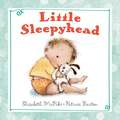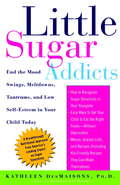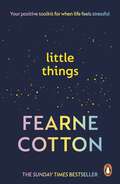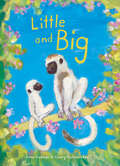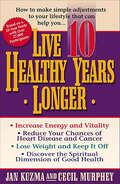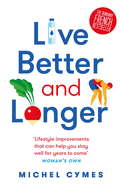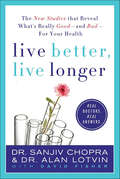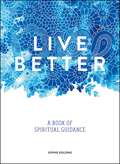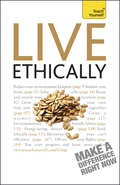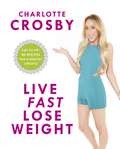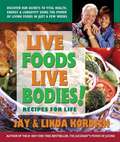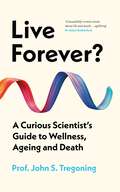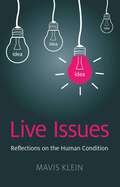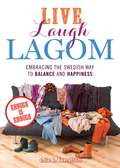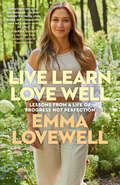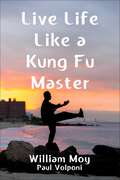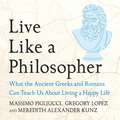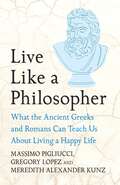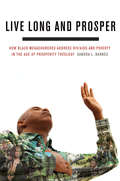- Table View
- List View
Little Rabbit's Loose Tooth
by Lucy Bate Diane DegroatWhen Little Rabbit's loose tooth finally comes out, she isn't convinced that the tooth fairy will really come. This is a new hardcover edition of a beloved classic.
Little Sleepyhead
by Elizabeth McPikeBaby's bedtime is more cuddly than ever! Tired little eyes, ready now for bed, Tired little everything, precious sleepyhead. By the end of a busy day, little knees are tired from crawling, little arms are tired from stretching—even little lips are tired from blowing kisses. But with the help of gentle verse, and art as sweet as a bedtime lullaby, tired little eyes will quickly give way to sleep. Shhh . . .
Little Sugar Addicts: End the Mood Swings, Meltdowns, Tantrums, and Low Self-Esteem in Your Child Today
by Kathleen DesmaisonsDesMaisons presents a seven-step program for ending sugar addiction and getting back the easygoing, well-balanced child. Included is advice on teaching kids to eat the "right" foods, without feeling deprived; recipes; and tips on eating in the school cafeteria, in restaurants, and at parties.
Little Things: Your positive toolkit for when life feels stressful
by Fearne CottonHow to make small changes to feel better, even when under stress.Stress is a normal part of life, but it can be overwhelming. The habits, tools and advice in these pages will help you cope better, understand your own worries, and learn how to pause and respond rather than react when life feels too much.This is the advice I've received - the lessons I've learned in my own ups and downs, the expert conversations from my Happy Place podcast, the therapies I've tried and the habits I've created - to keep working towards good days.By focusing on the little things, practising self-awareness, and getting creative with the exercises and simple ideas, daily tricks and practical tools in this book, you can find balance in our hectic world and unlock daily happiness.Fearne x
Little and Big
by Anne GutmanTwo lemurs–one little and one big–take turns wishing to be more like the other, in this lush, poignant picture book about life with a sibling set in the rainforest of Madagascar.It&’s nighttime in the rainforest, and when Mama tells young Faly to shut his eyes, he objects. &“Only if Mahandry sleeps, too,&” he tells his mother. &“But I am bigger than you, Faly,&” answers the older lemur brother. &“I am allowed to go to bed later.&” Thus begins a spirited back-and-forth and a family gambol that brings a mama and her two lemur sons from the hollow of their tree to a dangerous wide river crossing to a slippery rushing waterfall and eventually to a tall tree filled with orchids to snack on. And with each step, the brothers notice who gets help from mama or who gets the kind of independence that comes with being big. Each child desires both, and each child quietly reflects throughout on why he would rather be more like the other. No matter, it always seems true to one brother that the other has the advantage.Anne Gutman&’s poignant tale of siblings seesawing through a typical day en famille rings with truth, humor, and sensitivity. Georg Hallensleben's paintings of the rainforest in pinks, browns, and greens are a feast for the eyes and a treat for nature fans, and especially for young readers being introduced to the magic of the rainforest and its inhabitants for the first time.
Live 10 Healthy Years Longer
by Cecil Murphey Jan KuzmaDiscover the Live Longer Lifestyle—a plan for reducing disease risk based on the famed twenty-five-year Loma Linda health study.In Live 10 Healthy Years Longer, biostatician Dr. Jan Kuzma and Cecil Murphey make a startling connection between the spiritual and physical realms of our lives. After an in-depth twenty-five-year study involving more than 27,000 participants, they discovered an amazing medical breakthrough that offers each of us the potential to live longer, healthier and happier lives. The “live longer lifestyle,” based on Kuzma’s years of research in longevity, presents practical suggestions for reducing heart disease and cancer, losing weight, increasing vitality, enjoying life, and faithfully caring for the body that God has given each of us.
Live Better and Longer
by Michel CymesDid you know that pomegranates help reduce dental plaque? That fridges are germ factories? That those little everyday movements can wreck your back? The mega French bestseller that reveals the truth about healthy living, and why it's never too late.Good health is an invaluable gift. But how can you maximise your own individual potential? How can you give your body the best MOT it has ever experienced?This fantastically accessible and helpful book is based on 4 basic and essential principles:1) understanding superfoods - what they are, how they benefit your body and your mind and how to eat them;2) breaking harmful habits - how to change those bad habits of a lifetime;3) being fit - the importance of exercise, and how to incorporate it into your daily life;4) essential tips to stay in shape - from good sleep to cold showers, from gut health to brainfood, everything is covered!No one escapes their genetic heritage, nor their upbringing. But we are all responsible for what we decide to do about them. And what Michel Cymes promises is that it doesn't take much to go from a life marred by bad patterns of behaviour, to a life enhanced by good ones. In matters of health, in the end you reap what you sow. And what is special about this book is that it stimulates our capacity to think and act differently.This book is the friend who wants to see you succeed, the mate who knows you inside out. Whether you are a gym bunny or starting from scratch, Live Better and Longer gives you the best advice by France's most established doctor.
Live Better, Live Longer: The New Studies that Reveal What's Really Good—and Bad—For Your Health
by David Fisher Sanjiv Chopra Alan LotvinWE'VE ALL SEEN THE HEADLINES:The Pill That Can Prevent Cancer!A Guaranteed Way To Avoid Alzheimer's Disease!The Food That Lowers Bad Cholesterol!BUT WHAT SHOULD WE BELIEVE?ONCE UPON A TIME, maintaining your health seemed relatively simple. But today we're barraged by a never-ending array of conflicting medical advice. It's all terribly confusing, and most of us aren't sure what news we can trust and what we can ignore. Doctor Chopra Says offers a solution that will help you make the right decisions for your health.In this groundbreaking book, Dr. Sanjiv Chopra teams up with renowned cardiologist Dr. Alan Lotvin to give you the most cutting-edge medical research available. Doctor Chopra Says explains how you can tell the difference between true medical news and irrelevant media hype, covering such vital topics as:· Is wine the best medicine?· Which cancer screening methods are effective?· Is there a "best" diet for you?· What one vitamin should everyone be taking? (And why you can throw away all the rest.)· Are statins the new miracle drug?Filled with authoritative advice from many of the top medical experts in their respective fields, Doctor Chopra Says gives you the tools you need to lead a healthier, happier, and longer life.The media MYTHS, the medical FACTS,and health ESSENTIALS revealed . . . MYTH: Megadoses of vitamin E might stave off some cancers, Alzheimer's Disease, macular degeneration, and other serious health problems.FACT: Taken regularly over a long period of time, vitamin E supplements of more than 450 mg can be extremely dangerous.MYTH: Drinking too much coffee has been linked to health problems, including heart attacks, birth defects, pancreatic cancer, osteoporosis, and miscarriages.FACT: People who drink coffee have significantly reduced their chance of developing liver cancer.MYTH: Vaccines may cause extremely serious health problems, including autism.FACT: There is absolutely no evidence of a link between vaccines and autism.MYTH: People can get enough vitamin D3 from exposure to the sun for fifteen minutes a day.FACT: During the winter, people living north of about 35º latitude cannot get the necessary UV light from the sun.
Live Better: A Book of Spiritual Guidance
by Sophie GoldingYour spiritual journey can take many forms, and it’s important to choose the path that’s right for you. This handbook will introduce you to traditions and practices with the power to open your heart and broaden your mind. Along with practical tips and enlightening quotes, the insights here are stepping stones towards a better life.
Live Better: A Book of Spiritual Guidance
by Sophie GoldingYour spiritual journey can take many forms, and it’s important to choose the path that’s right for you. This handbook will introduce you to traditions and practices with the power to open your heart and broaden your mind. Along with practical tips and enlightening quotes, the insights here are stepping stones towards a better life.
Live Ethically: Teach Yourself
by Peter MacBrideLive Ethically will clear a path through the minefield of information available on green issues and give you everything you need to know in order to make informed choices about the goods, services and products you use on a daily basis.Designed for anyone who wants to live more responsibly without huge effort or cost, it is a realistic guide to understanding the issues surrounding every area of consumer life, from clothing and food to energy saving and environmentally friendly travel.Each section explains the pros and cons of every choice we make as householders, then shows the practical steps you can take to make changes that will really have an impact.NOT GOT MUCH TIME?One, five and ten-minute introductions to key principles to get you started.AUTHOR INSIGHTSLots of instant help with common problems and quick tips for success, based on the author's many years of experience.TEST YOURSELFTests in the book and online to keep track of your progress.EXTEND YOUR KNOWLEDGEExtra online articles at www.teachyourself.com to give you a richer understanding of how to live ethically.FIVE THINGS TO REMEMBERQuick refreshers to help you remember the key facts.TRY THISInnovative exercises illustrate what you've learnt and how to use it.
Live Ethically: Teach Yourself (Teach Yourself General)
by Mac BrideLive Ethically will clear a path through the minefield of information available on green issues and give you everything you need to know in order to make informed choices about the goods, services and products you use on a daily basis.Designed for anyone who wants to live more responsibly without huge effort or cost, it is a realistic guide to understanding the issues surrounding every area of consumer life, from clothing and food to energy saving and environmentally friendly travel.Each section explains the pros and cons of every choice we make as householders, then shows the practical steps you can take to make changes that will really have an impact.NOT GOT MUCH TIME?One, five and ten-minute introductions to key principles to get you started.AUTHOR INSIGHTSLots of instant help with common problems and quick tips for success, based on the author's many years of experience.TEST YOURSELFTests in the book and online to keep track of your progress.EXTEND YOUR KNOWLEDGEExtra online articles at www.teachyourself.com to give you a richer understanding of how to live ethically.FIVE THINGS TO REMEMBERQuick refreshers to help you remember the key facts.TRY THISInnovative exercises illustrate what you've learnt and how to use it.
Live Fast, Lose Weight: Fat to Fit: 80 recipes for a healthy lifestyle
by Charlotte CrosbyCharlotte Crosby's healthy lifestyle guide is bursting with all her favourite tips and tricks for what to eat when you're out and about, that can fit into even the busiest of schedules.Charlotte shares 80 simple and delicious recipes, including cocktails and hangover cures that don't contain thousands of calories, proving that you can eat healthily to look great while still having loads of fun!Charlotte is everybody's favourite down-to-earth reality star. When it comes to losing weight her mantra is: if she can do it, anyone can. In LIVE FAST LOSE WEIGHT she shares the recipes she cannot live without.
Live Fearless: A Call to Power, Passion, and Purpose
by Louie Giglio Sadie RobertsonSadie Robertson, bestselling author and star of Dancing with the Stars, has an important message for her generation: you don’t have to be held back by fear, anxiety, or loneliness anymore. In Live Fearless, Sadie takes you on a thrilling personal journey toward power, passion, and purpose as you live at the center of who God created you to be!Dear friends,I don’t know about you, but I’m pretty tired of the struggle. You know which one I mean—fear, loneliness, not knowing who I am or what I’m meant to do. . . . Sound familiar? I struggled with insecurity, comparison, and isolation for too many years, from thigh gaps to eyebrows to the lifestyles I felt I had to live up to. I was so afraid of being “found out,” that everyone in my life would somehow figure out that I was fearful and small and that I struggled to make my faith a reality and to be secure in who I am. It took a major perspective shift from staring at comments on a screen to really digging into the pages of my Bible to see what God actually says about overcoming fear.Setting aside the fear, anxiety, and comparison to become the joy-filled person God created you to be is exactly what God is inviting you into. To really be seen and known. To be an agent of change by choosing compassion, connection, and acceptance for everyone you come in contact with. Inside this book are ways to find your power, passion, and purpose—and reach for your dreams. Plus, there are places to jot down notes, fun lists, practical ways to make changes, and thoughts on how living fearless can change everything.Are you tired of the awful comparison game? Are you exhausted from trying to keep up, from feeling small and afraid that people will find the real you and be disappointed? There is so much more for you. No matter who you are, where you come from, or what your fears are, freedom is available to you. It’s just a matter of saying yes. You in?Hope you’ll join me on this wild adventure as we learn to Live Fearless together. Love, Sadie
Live Foods, Live Bodies!
by Jay Kordich Linda KordichAfter selling close to one billion dollars in juicers and writing a number-one New York Times bestseller, Jay Kordich—known worldwide as The Juice Man—realized that juicers were just the first step in teaching people about vital foods and energetic living. So many people now find themselves overweight, addicted to harmful foods, and unhappy with their lives. But Jay knows that a wholesome, satisfying life is within your reach—if you learn the secrets to good health. In this new book, Jay Kordich and his wife, Linda, reveal all their personal secrets, including juice therapy, living foods, and positive thinking. Live Foods, Live Bodies! was designed to help you transform the person you are into the person you want to become.This book is divided into two parts. Part One explores the power of the living enzymes found in fruits, vegetables, and especially greens—chlorella, green barley, wheatgrass, and more. It explains the many benefits of becoming a vegetarian, and it presents the dos and don&’ts of fresh juices—the very subject that propelled Jay to fame. Part Two puts it all together by laying out what&’s needed in the living kitchen; offering recipes for fantastic salads, dressings, meals, and drinks; and providing simple yet effective tips for using your new skills to create a better, more fulfilling lifestyle.Whether you are in your forties, in your fifties, or in your nineties, you can live healthier and happier, with increased vitality. With Jay and Linda as your teachers, you will discover a new world of great tastes and long-lasting health.
Live Forever?: A Curious Scientist's Guide to Wellness, Ageing and Death
by Prof. John S. TregoningTime wants you dead. Not just you, but your friends, family, pets – everyone you&’ve ever met… 'A beautifully written book about life and death: busts myths, explores the stories of science and history, and ultimately is rich and uplifting.' Dr Adam Rutherford With over 17,000 known diseases affecting humans, and countless poisons, carcinogens and toxins in our environment, it&’s a miracle that our bodies manage to keep us alive. And that is, of course, if they don&’t betray us themselves, whether through cancers or autoimmune conditions. Biomedical researcher Professor John Tregoning tells the unlikely story of how, against all odds, we manage to stay alive. Taking an organ-by-organ tour of the human body, Tregoning embarks on his own experimental quest, testing 'life-extending' diets and exercise regimes to separate fact from fad. Exploring the multitude of ways our bodies can kill us, from inherited genetic conditions, through heart attacks, arrythmias and angina, onto the delicate workings of the brain, Live Forever? offers compelling insight into how our bodies work, how we can best look after them – and ultimately live longer, healthier lives. *** 'I heartily recommend this deep dive into wellness... It turns out that none of us are getting out of here alive, but John has bravely put his mind and body on the line to discover the secrets of staying healthy and happy as we get older. A funny, fascinating and educative book.' Ben Willbond, co-creator of Ghosts 'The idea that a book about death and dying could be a delightful read seems ridiculous, and yet John Tregoning has pulled off this trick with humour, flair and elegance.' Nessa Carey, author of The Epigenetics Revolution 'An enjoyable and entertaining mixture of scientific facts about ageing and completely unscientific self-experimentation... recognizing that although none of us will live forever, there are ways we can improve our chances of living well while we are still around.' Dame Sarah Gilbert
Live Free from Asthma and Allergies: Use the BioSET System to Detoxify and Desensitize Your Body
by Ellen W. CutlerWhy simply alleviate asthma and allergy symptoms when you can address the root causes? In LIVE FREE FROM ASTHMA AND ALLERGIES, Dr. Ellen Cutler introduces the Bioenergetic Sensitivity and Enzyme Therapy (BioSET) system, a method of reprogramming the body'¬?s response to foods and environmental factors to provide real relief without the use of medication. This comprehensive manual explains how to use the BioSET system to treat yourself at home. Combining enzyme therapy with proper nutrition and a non-invasive desensitization technique that utilizes acupressure meridian points to fully clear and reprogram most sensitivities, this holistic program will free you from sniffles, sneezing, and wheezing for good.From the Trade Paperback edition.
Live Issues: Reflections on the Human Condition
by Mavis KleinThis book is a collection of 17 independent, opinionated and provocative essays on the various conceptual experiences of being human. Topics include: Ego States, Strokes and Transactions, Our Species, Duality Rules OK, Realities, Languages and Theories, Five Personality Types, Compound Personality Types, Personality Types in Relationships, The Enemies of Love, Men and Women, Morality, The Quest for Happiness, The Issue of Astrology, Life Stages, Zeitgeist, and The Life and Death of God. Most serious books are thought marathons; this serious book is a collection of thought sprints - perfect mind-bending for between stops on bus or train.
Live Laugh Lagom: Enough Is Enough--Embracing the Swedish Way to Balance and Happiness
by Lola ÅkerströmThrowing away all your stuff isn't going to make you happy. Conspicuous consumption isn't going to work either. But somewhere in the middle is lagom—the Swedish way to happiness based on the idea of not too much, not too little.Lagom is not just a word but the very essence of what it means to be a Swede. As you'll discover in this book, lagom is the secret to the enviable Swedish lifestyle of social consciousness, moderation, and sustainability.Guiding you to operate at your most natural, effortless state of contentment, Live Laugh Lagom teaches you to strive for the ultimate balance in all aspects of your existence, including well-being, relationships, work, finances, diet, and home life.
Live Learn Love Well: Lessons from a Life of Progress Not Perfection
by Emma LovewellA memoir chronicling Emma Lovewell&’s incredible path to physical―and mental―fitness that traces her journey to becoming a beloved Peloton instructor and inspires readers to live, learn, and love well&“Emma&’s spirit and spark are contagious . . . a great reminder that feeling whole, healthy, and balanced takes work but is always worth the effort.&”—Joanna Gaines, #1 New York Times bestselling author of Magnolia TableEmma Lovewell is a star instructor at Peloton, a global fitness brand and media content company, but her journey to success began with a simple realization: Change is inevitable, but growth is optional. She chose to grow. In Live Learn Love Well, she shares the moments in her life that shaped her into the woman she is today―from growing up in a modest home amidst the affluence of Martha&’s Vineyard, to struggling with her biracial identity and fitting in, both in the white community and the Asian American community, to health setbacks and relationship challenges, to moving to New York and striving for a career in dance and fitness.Just as Lovewell is more than a fitness instructor, she&’s learned that wellness is more than merely a physical condition. She shares the moments where mental fortitude shaped her outlook on the world and how the idea of &“progress, not perfection&” became a guiding principle.Filled with surprising insights, charming anecdotes, and never-before-shared moments, Live Learn Love Well is for anyone who feels stuck or overwhelmed, who worries there&’s too much to change to even get started, or who simply needs a little inspiration to make tomorrow better than today. Lovewell&’s stories, along with her easy-to-initiate tips, will give readers the confidence to know that even the smallest modifications can have truly outsized impacts on their lives and wellness.
Live Life Keto: 100 Simple Recipes to Live a Low-Carb Lifestyle and Lose the Weight for Good
by Jennifer BanzWith 100 easy, low-carb recipes, this essential cookbook and expert guide will help you start—and stick with—the ketogenic diet. The benefits of the keto diet are well established: It&’s proven to lower insulin levels, increase metabolism, and control hunger. For many of us, though, it can be intimidating to start—and extremely difficult to stay on plan. Author Jennifer Banz, a certified life coach and the founder of the popular blog Low Carb with Jennifer, has not only lost 50 pounds with keto, but she has also helped hundreds of people in her private program do the same with her simple 5 &“fail-stops&” to keto success. Live Life Keto shows how to change your mindset so you can stay compliant with keto and reap the rewards—weight loss, reduced cravings, increased energy, and more. Accompanied by full-color photographs, Live Life Keto shares a huge variety of delicious, uncomplicated recipes the whole family can enjoy, including: Energizing breakfasts like California Sheet Pan Omelettes, Sausage and Radish Breakfast Hash, and Cinnamon Crunch Bread Hearty soups, chowders, and stews, including Steak and Fauxtato Soup, Salmon Chowder, and Bacon and Mushroom Beef Stew Power lunches perfect for meal prep, such as Sloppy Joe Stuffed Portobellos and Bang Bang Chicken and Green Beans Crowd-pleasing appetizers like Loaded Guacamole and Baked Spinach Artichoke Dip Quick dinners, such as Taco "Cornbread" and Bruschetta Salmon Satisfying sides like Cheesy Baked Cauliflower and Roasted Cabbage Steaks Craveable desserts like Browned Butter Chocolate Chunk Cookie Cups and Snickerdoodle Mug Cake Essential low-carb condiments including sauces, spice rubs, and dressings With a focus on ingredients that are easy to find at any grocery store, plus tried-and-true advice to help you live keto for life, this book will become an indispensable companion on your journey to optimal health.
Live Life Like a Kung Fu Master
by Paul Volponi William MoyLive Life Like a Kung Fu Master is William Moy&’s personal invitation to become your teacher or &“sifu,&” as he presents over twenty attributes/techniques that will contribute to living a life made better by possessing Kung Fu. Attributes such as balance, structure, distance awareness, relaxation and traveling the shortest route between two points are presented both in terms of self-defense and in making an impact on your daily life—at home, school, work, business and social encounters. The text also features positional sketches drawn by William, as well as links to a number of videos in which William demonstrates physical techniques for students to model. William is joined on this literary Kung Fu journey by this long-time student and disciple, multi-award-winning author Paul Volponi. In turn, the co-authors are joined by several renowned martial artists, including Sammo Huang, Karen Sheperd, Grandmaster Tak Wah Eng, Grandmaster Doc-Fei Wong and Sifu Leo Imamura. A score of contributors such as basketball Hall of Famer Dave Cowens, two-time Olympic Gold medalist Kayla Harrison, glass-ceiling breaking baseball pitcher Ila Borders, famed tightrope walker Denis Josselin and World Scrabble Champion Joel Wapnick discuss how the attributes of Kung Fu relate to their many successes. The term &“Kung Fu&” actually translates as "time and effort equals a skill." That's why you see establishments with names such as Kung Fu Bread and Kung Fu Tea. These proprietors are not trumpeting their ability to fight. Rather, they're saying, we put in the time to study and learn our craft, and the result is that we are masters in our own arena—baking bread or brewing tea. In Asian culture, people who are said to have "good Kung Fu" have a handle on their lives. They are honest, direct, kindly and self-assured. These are values more highly prized than the ability to fight. What&’s the parallel between these prized qualities and the ability to physically defend yourself like a martial arts Kung Fu master? Kung Fu, especially Wing Chun Kung Fu, is based on a center-line theory of taking the shortest path, a straight line between two points, in defending yourself. It is also based on calmness and relaxation, enabling the practitioner to feel and quickly interpret incoming forces—therefore, bringing about a swifter and more focused reaction. Cultivating such abilities will allow you to transfer their martial benefits onto daily situations in your personal, social, and business interactions. William Moy&’s view of the teacher/student relationship is a simple one: &“Your sifu&’s role is to help you find your own Kung Fu.&” Hence, there are no cookie-cutter students. Each journey will be inherently different depending upon the individual student&’s physical attributes, personality and goals. In this very patient art, there are no failures, just students continuing on a path to their desired destination.
Live Like A Philosopher: What the Ancient Greeks and Romans Can Teach Us About Living a Happy Life
by Massimo Pigliucci Gregory Lopez Meredith Alexander KunzA wide-ranging philosophical and practical guide to incorporating the wisdom of ancient philosophers into daily modern life.What does life truly mean? Who do I want to become? And how do I get there? These are some of life's biggest questions that can be hard to think through. Fortunately, a group of philosophers from ancient Greece and Rome have already done a lot of the heavy lifting. Drawing on the philosophies, life lessons and experiences of key thinkers, Live Like a Philosopher will help you navigate these existential waters with invaluable insights for modern life.From finding balance with Aristotle and embracing uncertainty with Cicero to avoiding pain with Epicurus and learning how to rebel with Cynic Hipparchia, this is a powerful toolkit to help you navigate the highs and lows of modern life. Organized around three main themes of pleasure, virtue, and doubt, there's something to learn from each master in this philosophical quest. Live Like a Philosopher is the helping hand we all need to make life better.
Live Like A Philosopher: What the Ancient Greeks and Romans Can Teach Us About Living a Happy Life
by Massimo Pigliucci Gregory Lopez Meredith Alexander KunzA wide-ranging philosophical and practical guide to incorporating the wisdom of ancient philosophers into daily modern life.What does life truly mean? Who do I want to become? And how do I get there? These are some of life's biggest questions that can be hard to think through. Fortunately, a group of philosophers from ancient Greece and Rome have already done a lot of the heavy lifting. Drawing on the philosophies, life lessons and experiences of key thinkers, Live Like a Philosopher will help you navigate these existential waters with invaluable insights for modern life.From finding balance with Aristotle and embracing uncertainty with Cicero to avoiding pain with Epicurus and learning how to rebel with Cynic Hipparchia, this is a powerful toolkit to help you navigate the highs and lows of modern life. Organized around three main themes of pleasure, virtue, and doubt, there's something to learn from each master in this philosophical quest. Live Like a Philosopher is the helping hand we all need to make life better.
Live Long and Prosper: How Black Megachurches Address HIV/AIDS and Poverty in the Age of Prosperity Theology
by Sandra L. BarnesThis pioneering new study of the Black megachurch phenomenon brings nuance and depth to the question, Are Black megachurches more focused on prosperity than on people?Black megachurches and their pastors are often accused of failing to use their considerable resources to help the poor; focusing on prosperity theology rather than on social justice; requiring excessive monetary and time commitments of members; and pilfering church coffers for the their personal use. The debate rages on aboutwhether these congregations are doing all they can to address specific challenges facing African American communities. Live Long and Prosper is a refreshing, innovative study that reaches beyond superficial understandings of the Black megachurch phenomenon in a piercing interrogation of how powerful megachurches address (or fail to address) two social crises in the Black community: HIV/AIDS andpoverty.Live Long and Prosper offers an intriguing examination of sixteen representative Black megachurches and explores some of their motivations and subsequent programmatic efforts in light of prosperity or “health and wealth” theology. Professor Barnes makes the case that the Black megachurch is a complex, contemporary model of the historic Black church in response to globalism, consumerism, secularism, religious syncretism, and the realities of race. She contends that many of these megachurches hold unique characteristics of adaptability and innovation that position them well to tackle difficult social issues. Prosperity theology emphasizes two characteristics—physical health and economic wealth—as examples of godly living and faith. This book considers whether and how efforts to address HIV/AIDS (a “health” issue) and poverty (a “wealth” issue) are influenced by church and clergy profiles; theology, in general; and prosperity theology, in particular. Frame analysis informs this mixed-methodological study to compare and contrast experiences, theological beliefs, pastoral profiles, and programs.Live Long and Prosper is a must-read for general readers, academics, and students alike—indeed, anyone interested in the contemporary Black megachurch’s response to social problems and the link between theology and social action. It is at once a fascinating, readable narrative and a rich piece of scholarship complete withextensively documented endnotes, statistics, informative charts and tables, and an exhaustive bibliography.

